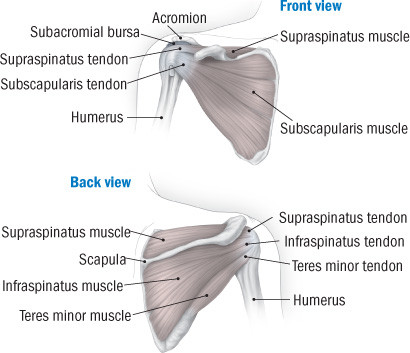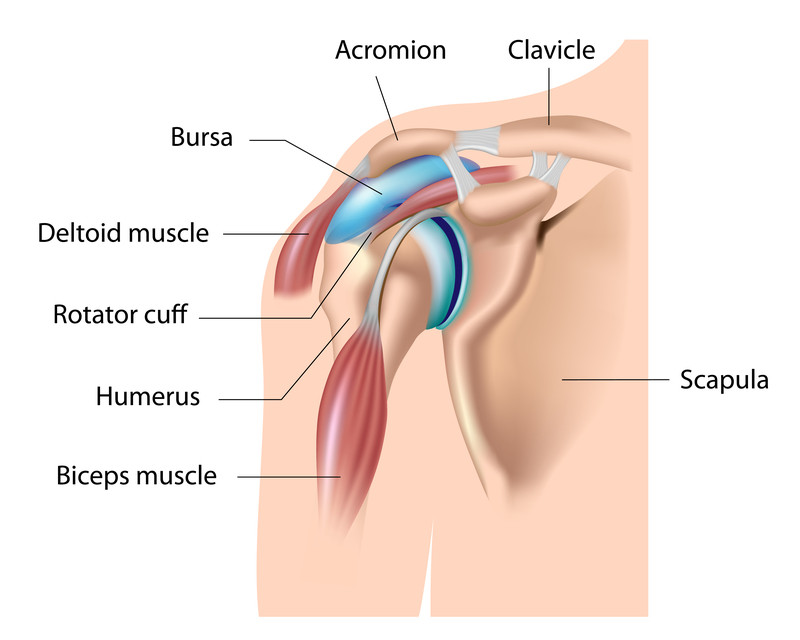Bursitis
- Reviewed by Robert H. Shmerling, MD, Senior Faculty Editor, Harvard Health Publishing; Editorial Advisory Board Member, Harvard Health Publishing
What is bursitis?
A bursa is a membrane-lined sac near a joint that acts as a cushion between the muscle and bone. The bursa reduces friction caused by movement and makes the joint more flexible.
|
Healthy shoulder |
Bursitis is inflammation of a bursa. It is a common condition that often happens when a joint is overused, such as when throwing a baseball or painting a wall. More rarely, bursitis can be caused by gout or an infection. Bursitis is more common in people who are overweight, elderly or diabetic, although it also develops in younger, healthy people without a clear reason.
|
Shoulder with bursitis (inflamed bursa) |
Symptoms of bursitis
Symptoms include:
- pain around such joints as the elbow, hip, shoulder, and knee, especially if pressure is applied to the area or with use
- redness, warmth and swelling — these are less common and may mean the area is infected.
Diagnosing bursitis
After reviewing your symptoms and recent activities, your doctor will examine you and press on the painful area to determine whether the pain is located over a bursa. Typically, your doctor will be able to move the joint through its normal range of motion, but if you try to move the joint yourself, you may not be able to move it as far because of pain. Your doctor also may order X-rays to check for other conditions. If you have bursitis, the X-rays will often be normal, although a small calcium deposit may be present. If your doctor suspects that gout or an infection is causing your bursitis, he or she may recommend that you have a test in which a sample of the fluid is removed from the bursa for analysis. This is a minor procedure.
Expected duration of bursitis
Bursitis usually lasts for only days or weeks, but it can last months or years, especially if the cause, such as overuse, is not identified or changed.
Preventing bursitis
The best way to prevent the most common type of bursitis is to avoid repetitive motion of a joint, especially if you are overweight. Losing weight may reduce the risk of developing bursitis in your legs. If repeated stress on a bursa cannot be avoided, protective gear can help prevent bursitis. For example, carpet layers who spend time kneeling may need protective knee gear.
Treating bursitis
If you modify your activities and rest the joint, symptoms should go away within days or sometimes weeks. In the meantime, you may want to take an anti-inflammatory drug such as aspirin or ibuprofen (Advil, Motrin and others) to relieve discomfort and reduce the inflammation. Acetaminophen (Tylenol) and physical therapy also may be effective. If bursitis is caused by an infection, you may need drainage of the bursa and treatment with an antibiotic. When the pain is intense or does not improve in a short period, your doctor may inject a corticosteroid drug directly into the area. However, repeated steroid injections over a short time can be damaging and steroid injections are avoided when infection is present.
When bursitis occurs repeatedly in the same joint, the bursa may be removed surgically, although this is rare. Surgery also may be needed if you have an infection in the bursa that does not clear up when you take antibiotics.
When to call a professional
If you have significant pain or swelling in or near a joint, contact your health care professional.
Prognosis
The outlook for most people with bursitis is excellent. The condition usually lasts a short time and improves rapidly with treatment. A small number of people with bursitis will be bothered for a prolonged period. However, even in those cases, bursitis rarely leads to disability or permanent deterioration in function.
Additional info
American College of Rheumatology
https://www.rheumatology.org/
Arthritis Foundation
https://www.arthritis.org/
American Academy of Orthopaedic Surgeons (AAOS)
https://orthoinfo.aaos.org/
About the Reviewer

Robert H. Shmerling, MD, Senior Faculty Editor, Harvard Health Publishing; Editorial Advisory Board Member, Harvard Health Publishing
Disclaimer:
As a service to our readers, Harvard Health Publishing provides access to our library of archived content. Please note the date of last review or update on all articles.
No content on this site, regardless of date, should ever be used as a substitute for direct medical advice from your doctor or other qualified clinician.














